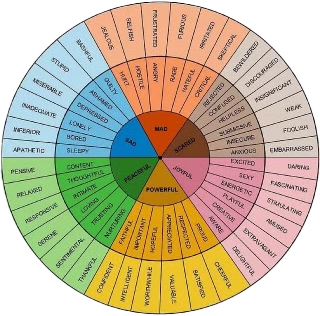In today’s pandemic world, it is probably safe to say that everyone on this planet at one point or another has experienced some level of arresting anxiety. It’s a topic that has been front and centre even pre-pandemic. Over the past two years of blogging, I’ve written about the topic but primarily for adults. This blog will focus on how the vicious cycle of worry and perfectionism can prevent our children from moving forward and what we as adults can do to help support them (and ironically learn to soothe our own anxiety regarding our kids).
This blog by Will Meek highlights the complexity of anxiety. So often a person will refer to anxious feelings or suffering from anxiety attacks, but as Meek points out that anxiety commonly is a secondary emotion masking the root emotion and triggering circumstance. Anxiety has been the acceptable catch-all phrase used today to describe swirling roadblock emotions. It can be a great cryptic label allowing us to avoid what is really the issue.


Brene Brown and Marc Brackett remind us the starting point in dealing with emotions is being able to dissect them in a situation and identify them. As adults, we find this difficult even with all our life experiences. Our naive children find it even more difficult. Hence, as the life sherpas for our kids, the greatest gift we can pass on to our children is the life coping skill of getting in touch with personal feelings.
The easiest way to approach your child about anxiety is through play and non-confrontational dialogue. In other words, go in the back door. Find a time when you and your child are relaxed. Beginning with sharing an anxiety-inducing experience of your own then sharing how you came over it might be a gentle way of approaching the topic. There are links below that offer games, books and activities to use as tools to help open the discussions on what worries us.
A tougher time to tackle this emotion is at the height of the anxiety stronghold. When younger children get anxious it is often a time that he/she might withdraw (freeze), run away (flight), or have a tantrum (fight). In the interest of dealing with the situation, catching the emotions when they are fresh, the best strategies are as follows:
- Find a quiet place to direct your child, off to the side, speak in a calm soothing voice, try to comfort him/her with hugs (this wasn’t always welcomed by my son who was in a raging tantrum).
- Offer distractions to redirect their focus. My hubby was great at distracting our kids when they were upset. It could be as simple as pointing out something different to look at, pulling out their security item (such as a soother, blankie or stuffie), or offering a drink or quick on-hand snack.
- If you have a picture storybook on hand grab it and offer a quick impromptu storytime. Or if no story is available, why not make one up on the spot, or retell a story that your child might hold as a favourite.
- Once your child has calmed down. Consider patiently asking these questions:
- How were you feeling before? How do you feel now?
- You seemed upset.


Then slowly go through emotions in a playful dramatic way. These questions are directed and specific but they are to help a child focus when they are feeling overwrought with emotion and confusion. Start with the obvious emotions like anger (Did you feel angry like a tiger?), sad (Were you sad like a cooing dove?) and scared (Were you scared like a quivering bunny?). You might want to probe further asking if he/she was frustrated (either because felt not heard, misunderstood, or not able to perfect a task), lonely, jealous (Afraid of losing a friendship), want something that is unavailable? Bottom line is that you are asking questions to help your child identify what triggered their reaction, what need or want wasn’t being met and help them give a label to that emotion.
At this point you can affirm your child for calming down and expressing their feelings then suggest revisiting the circumstance that triggered the anxiety with a discussed game plan of how to improve the situation so those anxious feelings don’t resurface. On the other hand, you might have to put the triggering situation on hold and suggest tackling it on another day after your child feels more prepared. Ultimately you want to engage your child in planning and taking steps in overcoming their anxiety-inducing activities rather than rescuing them.
Or take a look at this blog post which has great suggestions in helping your anxious child work through their feelings.
In summary, anxiety can grow into a debilitating monster. It is complex and often is tangled with a variety of other emotions. Things can seem overwhelming as a parent trying to deal with one’s own worries while trying to dispel fears and support our children. There are a ton of resources available to parents, grandparents and educators to help us support children in identifying anxiety triggering events and strategies to battling the fight, flight and freeze reactions. I leave you with a long list which is just a tiny example of online resources. May you and your children slay that Anxiety Monster!


Quick Take Away Links
A great insightful blog from a high-functioning anxiety sufferer:
Anxiety Support Books for our Kids:
Games to help work through anxious feelings:
Activities:
Parenting:
- https://www.anxietycanada.com/articles/managing-an-anxious-child-where-to-start/
- https://kidshealth.org/en/parents/temper.html
- https://www.nbcnews.com/better/lifestyle/mental-health-check-14-questions-ask-your-child-ncna1006936
- https://gozen.com/8-ways-a-childs-anxiety-shows-up-as-something-else/
- https://kidshelpline.com.au/parents/issues/helping-kids-identify-and-express-feelings
When our kids don’t understand what they are feeling they often defer to temper tantrums:
- https://www.parentingforbrain.com/self-regulation-toddler-temper-tantrums/
- https://www.verywellfamily.com/how-to-help-an-overly-emotional-child-4157594
Fun and engaging strategies to teach emotions to kids:
Great parenting phrases to practice:
A cute song on video:
MC’s former anxiety blog posts:







